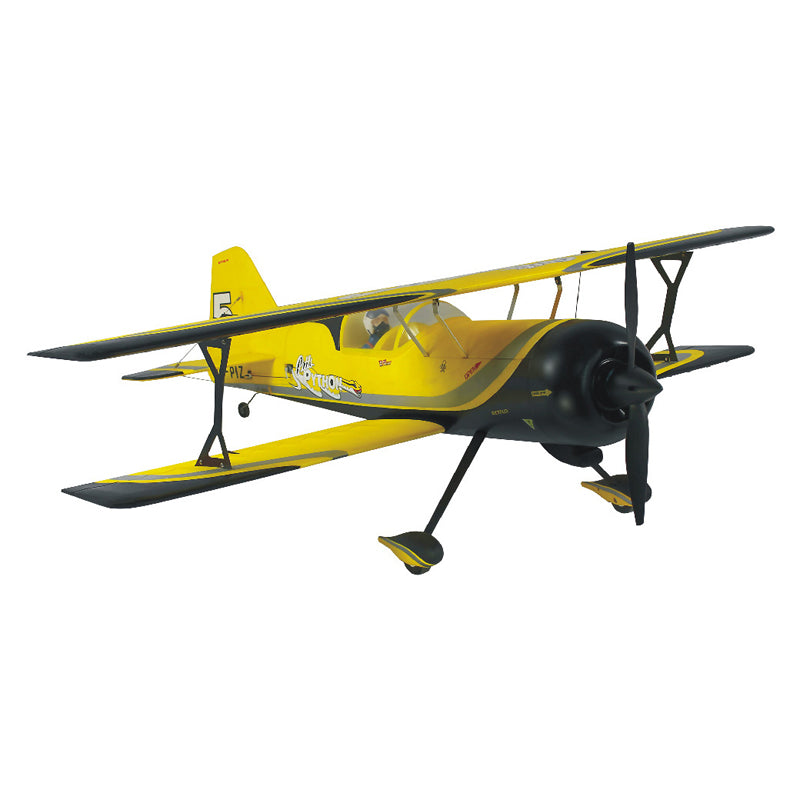As an RC pilot with over a decade of experience in aerobatic and 3D flying, I’ve learned one truth the hard way: center of gravity (CG) isn’t just a technical checkbox—it’s the heartbeat of precision and control. Today, I’ll unravel why CG matters, how Dynam’s Pitts Python Model 12 Yellow 4S RC Aerobatic 3D Sport Biplane exemplifies this principle, and why this aircraft has become a staple in my hangar.

What Makes CG the Unsung Hero of Aerobatics?
The Physics Behind CG in 3D Flight
In aerobatic RC planes like the Dynam Pitts Python, the CG determines how the aircraft responds to pilot inputs. Too far forward, and the plane becomes nose-heavy, sluggish in pitch, and struggles with tight maneuvers like prop hangs or flat spins. Too far rearward, and it turns twitchy, risking instability or even uncontrollable stalls6.
For 3D flying—think knife-edge passes, torque rolls, and hovering—the CG must be optimized to balance agility and stability. The Dynam Pitts Python Model 12, with its 1067mm wingspan and lightweight EPO foam construction, is designed to hit this sweet spot, but only if you dial in the CG correctly35.
Dynam Pitts Python Model 12: A Masterclass in Aerobatic Engineering
Historical Roots & Design Philosophy
The Pitts Python Model 12 pays homage to the full-scale aerobatic biplane powered by the Vedeneyev M14P engine. Dynam RC’s engineers stretched the fuselage slightly to enhance pitch damping while preserving the iconic biplane silhouette39. This tweak improves stability during aggressive maneuvers—a critical factor for pilots pushing the limits of 3D flight.
Key Performance Features 357
| Specification | Detail |
|---|---|
| Wingspan | 1067mm (42″) |
| Weight | 1300g (flying weight) |
| Motor | Detrum 650KV brushless outrunner |
| ESC | TomCat Skylord-50A |
| Battery | 4S 14.8V 2200–3000mAh LiPo (user-adjustable for CG optimization) |
| Control Surfaces | Oversized ailerons, dual 17g servos for rudder/elevator |
The Python’s carbon fiber and alloy struts add rigidity without weight penalties, while its 4S power system delivers explosive thrust-to-weight ratios—essential for vertical climbs and snap rolls7.
My Hands-On Experience: Taming the Python
When I first unboxed the Dynam Pitts Python, two things stood out: its bold yellow finish and the thin, flexible tail surfaces. A common gripe among pilots is the 5mm-thick EPO foam tail, which can warp during shipping. My fix? Diagonally reinforced carbon rods and a coat of water-based polyurethane (WBPU) to stiffen the structure7.
CG Tuning: From Theory to Practice
The manual recommends a CG range of 85–90mm from the leading edge. I started at 87mm using a 2200mAh 4S battery but noticed sluggishness in harriers. Shifting the battery 10mm rearward (CG ~92mm) transformed responsiveness—suddenly, the plane tracked like a laser in knife-edge and held prop hangs effortlessly.
Pro Tip: Use Velcro strips to fine-tune battery placement. The Python’s cavernous battery bay accommodates up to 3000mAh packs, but lighter batteries (1800–2200mAh) favor agility7.
CG Adjustment Checklist for Aerobatic Mastery
- Test Glide: Hand-launch without power to observe pitch behavior.
- Trim in Steps: Adjust CG incrementally (2–3mm shifts).
- Stress-Test Maneuvers: Evaluate snap rolls, hovers, and inverted flight.
- Document Changes: Track battery positions and CG outcomes.
FAQ: Demystifying CG and the Pitts Python
Q1: How does CG affect 3D maneuvers?
A: Forward CG enhances stability for precision aerobatics (e.g., loops), while rearward CG unlocks agility for 3D tricks like torque rolls. The Python’s design allows pilots to experiment within a 5–10mm range67.
Q2: Can I fly the Pitts Python without a gyro?
A: Absolutely. While gyros (e.g., iStone stabilizers) smooth out wind turbulence, the Python’s inherent stability—thanks to its stretched fuselage and wing loading of 43g/dm²—makes it forgiving even in gusty conditions59.
Q3: What’s the biggest CG mistake beginners make?
A: Overcompensating. A 2mm CG shift can drastically alter flight characteristics. Start conservative, and adjust incrementally.
Why Dynam’s Design Philosophy Wins
Dynam’s commitment to balancing affordability and performance shines in the Pitts Python. The Detrum 650KV motor and 50A ESC deliver relentless power, while the EPO foam construction survives inevitable “unscheduled landings.” My Python has endured mid-air collisions, cartwheels, and a tree strike—yet it’s still airworthy after minor repairs711.
Conclusion: CG Isn’t Just Technical—It’s Artistic
Mastering CG in RC 3D planes like the Dynam Pitts Python Model 12 is akin to tuning a musical instrument. Each adjustment refines the harmony between pilot and machine. Whether you’re chasing competition trophies or weekend adrenaline, remember: the right CG transforms physics into poetry.
For those ready to elevate their aerobatic game, the Pitts Python isn’t just a plane—it’s a canvas. And with Dynam’s engineering as your brush, the sky’s the limit.




